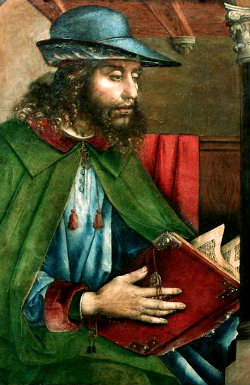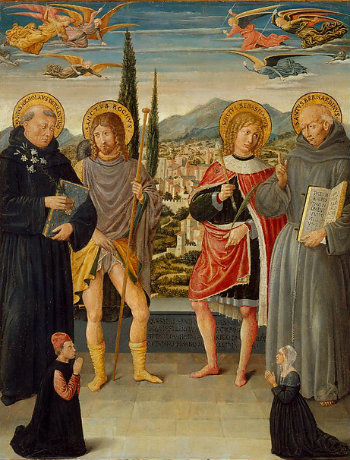100 Greatest Painters Artists Alphabetically Artists by Country Artists by Century Artists by Movement
The
Hidden Symbolic Meaning of Books in Western Art
From the earliest period of Christian history the clergy realized the value of images in keeping sinners on the road to heaven. According author and art historian, Carleton Noyes "The incident of the single canvas, which by its illuminating revealment first discloses to the observer the true significance of pictures, is typical of the whole scope of art. The mission of art is to reveal. It is the prophet's message to his fellow men, the apocalypse of the seer. The artist is he to whom is vouchsafed a special apprehension of beauty. He has the eye to see, the temperament to feel, the imagination to interpret; it is by virtue of these capacities, this high, transfiguring vision, that he is an artist; and his skill of hand, his equipment with the means of expression, is incidental to the great fact that he has somewhat to express that the common man has not. To his work, the manifestation of his spirit in material form, his perception made sensible, is accorded the name of art."
From the of time of the Roman persecution Christians used signs and symbols to secretly identify each other. The Church commissioned sacred images that acted as moral instruction to illiterate serfs who clamored for spiritual enlightenment of the holy scriptures. The religious images, carvings and stone work served as a constant reminder of the hellish tortures that awaited backsliders and sinners if they strayed from Gods word and church law. Byzantine, Gothic, Northern Renaissance and Italian Renaissance paintings are rich in philosophical Christian symbolism regarding Books.

Detail image of a painting by Pedro Berruguete
Open book - signifies education, knowledge and wisdom. Apostles and Saints are often shown with open books. The Virgin Mary is frequently shown holding an open book, symbolic of her submission to Gods Holy Law.

Detail image of a painting by Benozzo Gozzoli
The open heart-shaped book - Saint Augustine (354-430) was regularly depicted sitting at his desk with an open heart-shaped book, symbolic of his passion for truth and reverence for the Word of God, the ultimate source of light and truth.
Closed book - symbolizes incomplete knowledge. May also indicate the presence of heretics and rejection of Gods Holy Law in favor of heretical doctrines. A closed book also indicates the Kingdome of Heaven is closed to non-believers.
Book with a cross on the cover - symbolizes the word of God, Gods Devine Law, Church Law and Papal authority. The Apostles are frequently depicted holding a book representing the New Testament.
Open book with pages torn out, strewn about- symbolizes rejection of knowledge, reason, honor and morality, or a rejection of faith and church authority.
Book with coins on top, may symbolize wealth and greed over knowledge and philanthropy.
Old man with a beard holding a book or scroll represents St. Peter, St. Matthew or St. John
Balding man with a beard holding a book represents St. Paul.
Disheveled, scraggly haired old man holding a scroll or book represents St. Andrew.
From the earliest period of Christian history the clergy realized the value of images in keeping sinners on the road to heaven. According author and art historian, Carleton Noyes "The incident of the single canvas, which by its illuminating revealment first discloses to the observer the true significance of pictures, is typical of the whole scope of art. The mission of art is to reveal. It is the prophet's message to his fellow men, the apocalypse of the seer. The artist is he to whom is vouchsafed a special apprehension of beauty. He has the eye to see, the temperament to feel, the imagination to interpret; it is by virtue of these capacities, this high, transfiguring vision, that he is an artist; and his skill of hand, his equipment with the means of expression, is incidental to the great fact that he has somewhat to express that the common man has not. To his work, the manifestation of his spirit in material form, his perception made sensible, is accorded the name of art."
From the of time of the Roman persecution Christians used signs and symbols to secretly identify each other. The Church commissioned sacred images that acted as moral instruction to illiterate serfs who clamored for spiritual enlightenment of the holy scriptures. The religious images, carvings and stone work served as a constant reminder of the hellish tortures that awaited backsliders and sinners if they strayed from Gods word and church law. Byzantine, Gothic, Northern Renaissance and Italian Renaissance paintings are rich in philosophical Christian symbolism regarding Books.

Detail image of a painting by Pedro Berruguete
Open book - signifies education, knowledge and wisdom. Apostles and Saints are often shown with open books. The Virgin Mary is frequently shown holding an open book, symbolic of her submission to Gods Holy Law.

Detail image of a painting by Benozzo Gozzoli
The open heart-shaped book - Saint Augustine (354-430) was regularly depicted sitting at his desk with an open heart-shaped book, symbolic of his passion for truth and reverence for the Word of God, the ultimate source of light and truth.
Closed book - symbolizes incomplete knowledge. May also indicate the presence of heretics and rejection of Gods Holy Law in favor of heretical doctrines. A closed book also indicates the Kingdome of Heaven is closed to non-believers.
Book with a cross on the cover - symbolizes the word of God, Gods Devine Law, Church Law and Papal authority. The Apostles are frequently depicted holding a book representing the New Testament.
Open book with pages torn out, strewn about- symbolizes rejection of knowledge, reason, honor and morality, or a rejection of faith and church authority.
Book with coins on top, may symbolize wealth and greed over knowledge and philanthropy.
Old man with a beard holding a book or scroll represents St. Peter, St. Matthew or St. John
Balding man with a beard holding a book represents St. Paul.
Disheveled, scraggly haired old man holding a scroll or book represents St. Andrew.
Popular Questions About Art History
What
was the impact of Japanese
Prints on Post Immpressionist painters in the late 19th
century?
How did the Black Death impact European art history?
How did the Inquisition impact European art history?
What was the influence of the Medici Academy on Renaissance painters?
How did the Bonfire of the Vanities impact Italian Renaissance?
What role did Entartete Kunst play in 20th cetury art?
☼☼☼☼☼
If you feel you have worthwhile information you would like to contribute we would love to hear from you. We collect essential biographical information and artist quotes from folks all over the globe and appreciate your participation. When submitting please, if possible, site the source and provide English translation. Email to historyofpainter@gmail.com
© HistoryofPainters.com 2017
Copyright © historyofpainters.com.